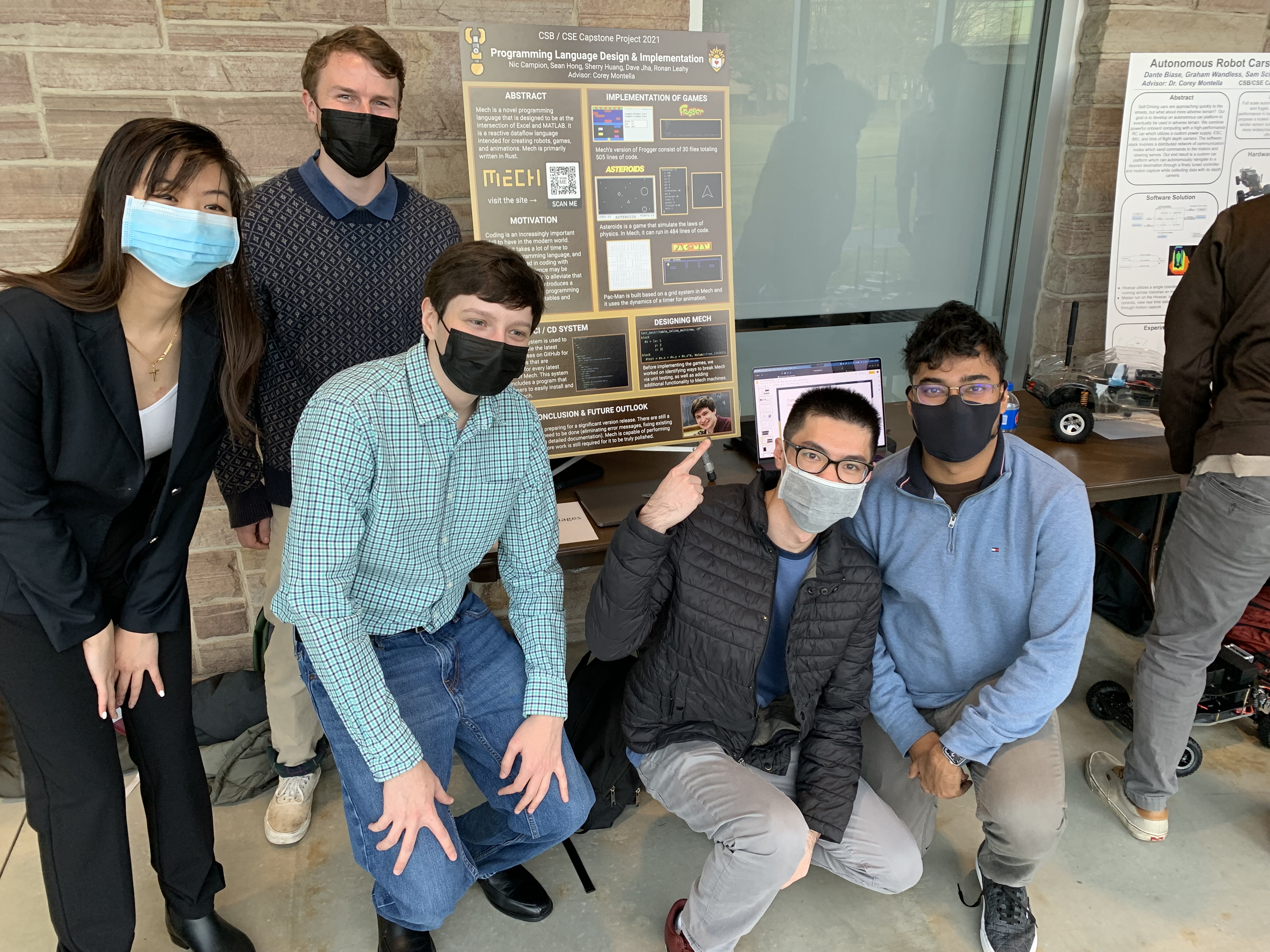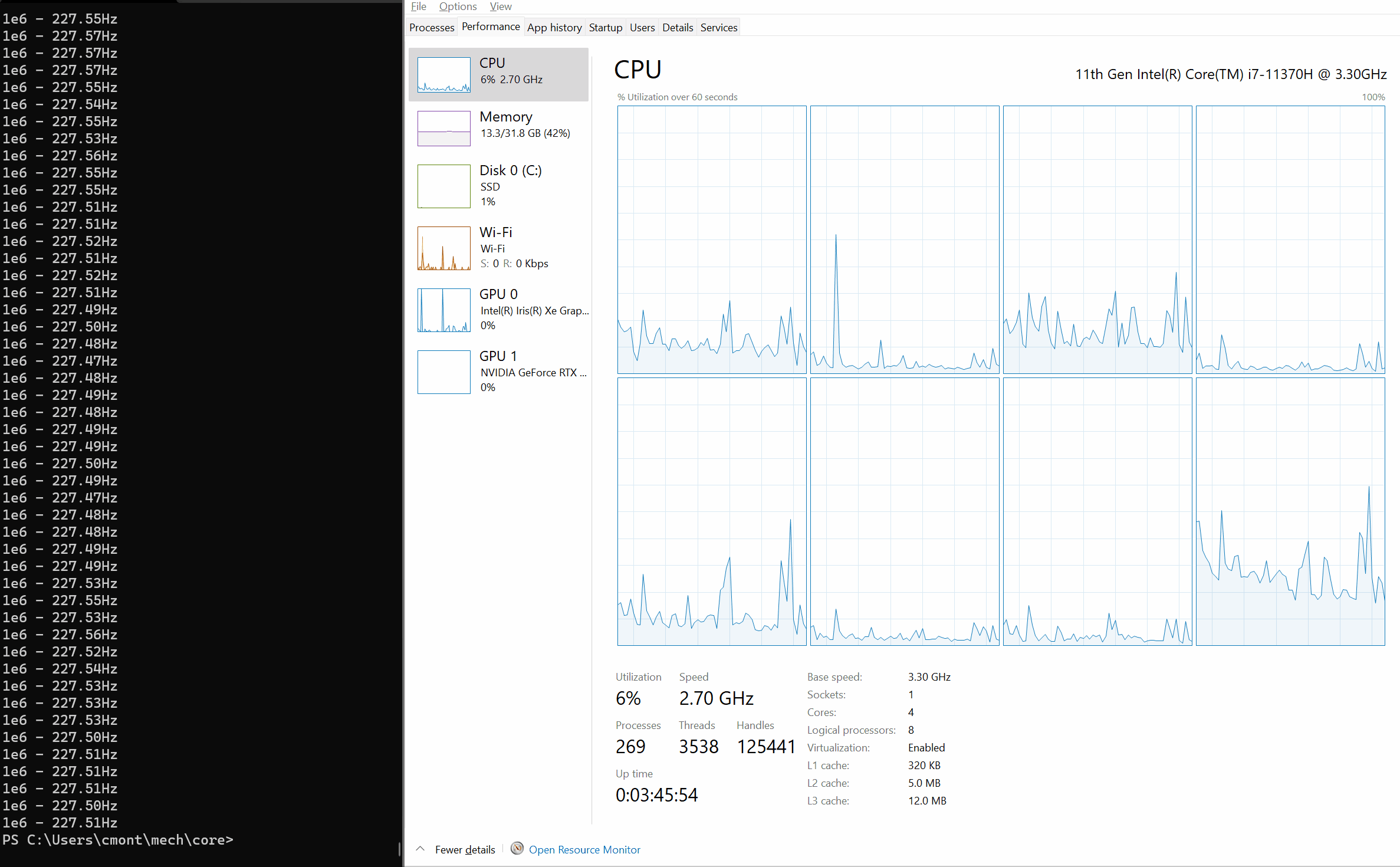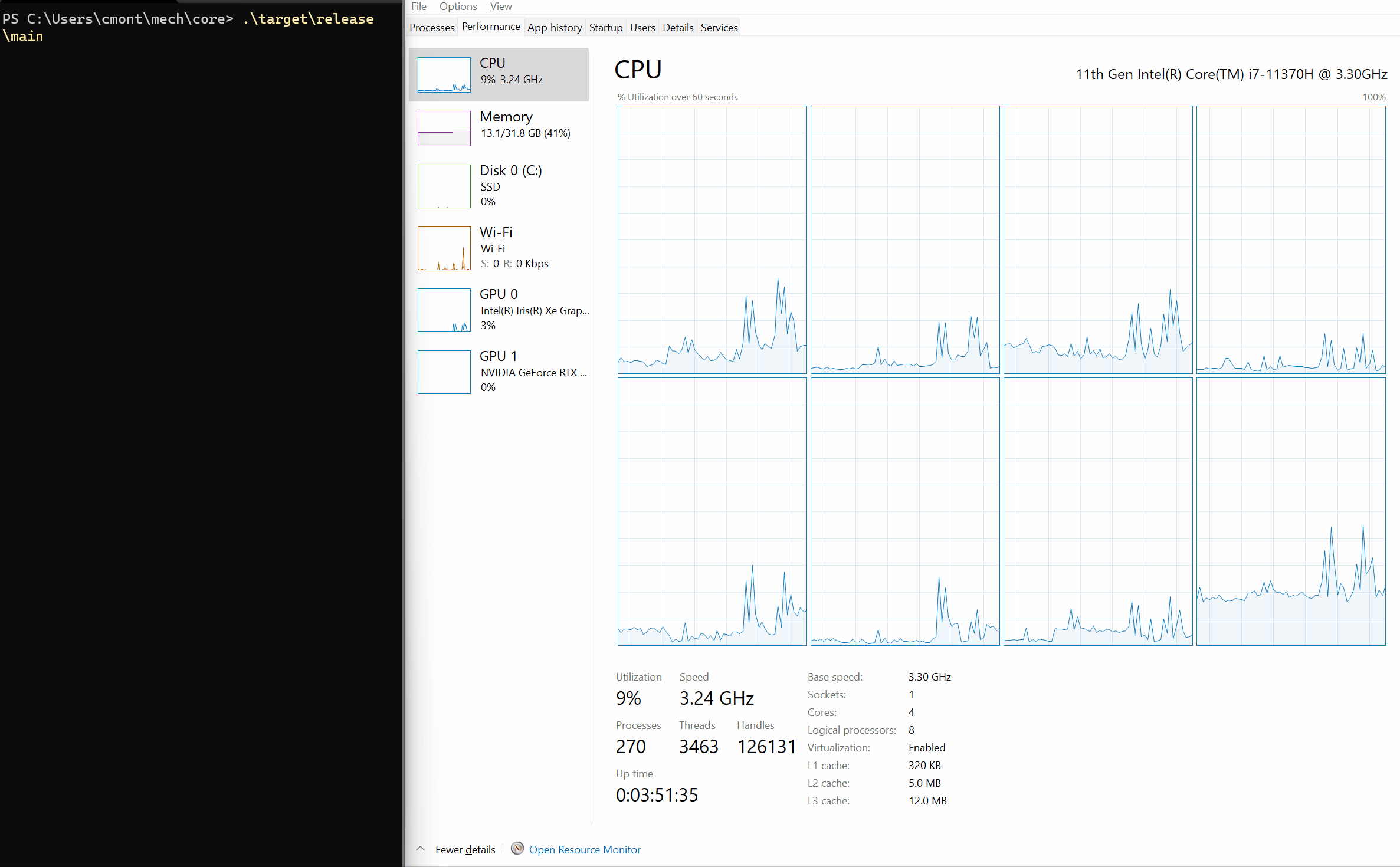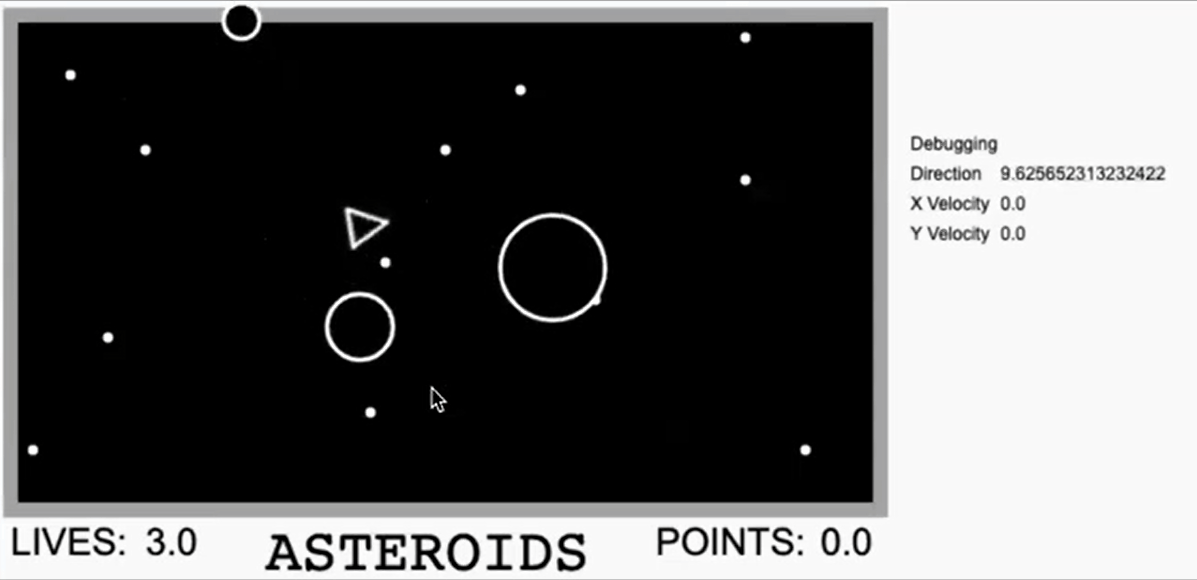Hello everyone and Happy New Year! Mech changed a lot in 2021 -- so much that it's almost ready for its first beta release in 2022. Development of the Mech language has been relatively underground lately, causing some to wonder if the project was dead. Mech is very much alive, but I've been quiet about it since the pandemic started. The last time I spoke publicly about Mech was at Live 2019 in October of that year. If you are new to Mech, the above 2019 paper is a good place to learn about the basics of the language.
Since then, Mech has been rewritten a couple times, and I think it will get to a state that is ready for public consumption in 2022. Therefore, I plan to be a lot more public about Mech this year in order to get the word out. To that end, let's take a look at what has happened to Mech in the last couple of years, and where it's headed in 2022!
People
I wanted to start by thanking everyone who has been involved with the Mech project. First, thank you to the 2020 Mountaintop Summer Experience group: Allison Codi, Zack Coriarty, Thanos Kougionis, and Sarah Pontier, who worked on the Forward Robotics initiative. They developed a curriculum that incorporates Mech and Sphero robots into fun learning activities for middle school students. You can learn a little more about their work here.
Also thanks to my 2021 Lehigh CSE Capstone team: Nic Campion, Sean Hong, Sherry Huang, Dave Jha, and Ronan Leahy. Sean, Dave, and Ronan worked to stress test Mech by implementing classic arcade games. Sherry and Nic worked on scripting the Mech CI/CD pipeline. You can see their final capstone presentation here.

Photo Caption: The 2021 Mechanics at the Lehigh University Capstone Demo Day.
Finally, there are several other students who have been involved and helped in various ways (too many to list) including Mika Kizuka, Robin Maillard, Michalina Modzelewska, Alan Wang, and Brian Zhu. Thank you for all your help with Mech these couple of years, it's been fun working on this project with you, and I hope you'll continue to be involved in the future!
And for anyone else I may have missed, I'm sorry, but thank you too!
Project Status
Mech is currently at the alpha stage of development. It's hard to use because there are no error messages yet, and there isn't a lot of documentation. Also some features remain unimplemented. Nevertheless if you know how to use it, it does currently do useful things. Its primary applications to date have been implementing classic arcade games using canvas, and serving as the core of an experimental operating system called Hivemind. It also has been used to power a robot.
When I've implemented at least a prototype of every planned feature (with basic documentation), I will certify Mech as ready for public consumption. My current target for completing the work necessary to release Mech v0.1-beta is October of this year. There are details about a proposed roadmap and timeline at the end of this post.
2021 TL;DR
The topline Mech features that were added or enhanced in 2021 were:
- Implemented a distributed, parallel, asynchronous runtime (WIP)
- Module system with a package manager were improved and a standard library was expanded (WIP)
- Added new example Mech games implemented using enhanced drawing and events capabilities (WIP).
Parallel, Asynchronous, Distributed Runtime
The bulk of 2021 was spent on a runtime rewrite that leverages data parallelism where possible, which is now mostly in place. This rewrite started as an attempt to take performance of Mech programs more seriously. In the figure below, you can see the results of some profiling I did of the bouncing balls game versus a Python implementation:

Initially Mech performed much worse than Python, but after some tuning guided by the excellent Superluminal Profiler, I managed to get about a 10x performance improvement (from 3Hz to 40Hz for N=1e6). Not bad, but I was bitten by the optimization bug at this point, and I couldn't see a way to improve performance further without a big rewrite to leverage the inherent parallelism of this problem.
Parallel
In this benchmark, N refers to the number of balls being simulated. For instance, consider the following block:
~ #time/timer.tick #ball.x := #ball.x + #ball.vx #ball.y := #ball.y + #ball.vy #ball.vy := #ball.vy + #gravity
This would be read as "Whenever the timer ticks, update the position and velocity of the ball using its current position and velocity." The thing to remember about Mech though, is that each variable is actually a vector e.g. #ball.x selects an entire column vector from the #ball table, representing the x coordinates of N simulated balls.
Operators and functions work element-wise in Mech, so this block represents 3N independent addition and assignment operations. There is a lot of inherent parallelism that can be exploited here! In recognition of this, I changed the Mech runtime in a few important ways:
First, table columns are now typed. This means that instead of accepting a Value enum that can be anything, column entries must be homogenous e.g. all unsigned 8-bit integers. This allows the Mech compiler to take advantage of automatic vectorization that enables parallelism when appropriate. You can see the result of that in the figure below, showing the execution of the bouncing balls program:

Now instead of running at ~40Hz, the program runs at over 200Hz. This is not quite a fair comparison, because the machines are different. I'll have to do a fairer comparison later, but another order of magnitude improvement isn't unreasonable given how much vectorization we were leaving on the table before.
Second, this also means that we can automatically parallelize most built-in operators beyond what the Rust compiler manages. Below are the results of using the Rayon work-stealing parallelism crate to run the bouncing ball program:

This yields a 64% percent speedup over the standard Rust iterators, and we can see that CPU utilization is at 100%. Without the video recorder sucking up precious cycles, the benchmark runs at ~420Hz. Unfortunately, there is some overhead associated with the use of the Rayon crate such that it's not beneficial unless N exceeds a certain usually very high threshold. Potentially what we can do here is switch between regular or parallel iterators depending on how large the operands are, but this is a work in progress.
Asynchronous
Work started on scheduling blocks to execute asynchronously within a core. Consider a file I/O operation, such as opening a file to read the contents:
#file/read += [path: "myfile.txt"]
We can then use the file contents when they are available:
#x = #file/read.contents
Mech will automatically make sure the variable #x is updated when the contents become available. What's cool is that any kind of I/O operation works this way, including HTTP requests.
One very interesting possibility this opens up is the ability to offload computations onto other hardware, like a GPU or remote CPU. Running a computation on a GPU can be viewed as asynchronous operation, because data must be written to and read from the GPU's main memory into the main system memory. Therefore, we began investigating the possibly of offloading these computations onto one or more GPUs (again, very much a WIP).
You'll notice the conspicuous absence of any async or await keywords. That's because asynchrony is built into the semantics of Mech programs. The flip side of this is that explicitly ordering blocks can be a bit of a pain. However, I believe we can use state machines to help with this problem, and maybe get the best of both worlds. One interesting thing to do here would be to add the ability to specify where you want a computation to occur e.g. on a remote core or on a GPU. Right now, a computation defined on a core will execute on that core. This is an area of active research and very preliminary.
Distributed
Work finally began on making the Mech runtime distributed, which enables the ability to write multiplayer games. For instance, consider a game of Pong, seen below running in distributed Mech on three different computers:
The game is architected as a client-server network. Two game clients (the players) connect to a centralized game server. The clients are responsible for rendering the game state to the players' screens (the score, positions of the two paddles and the ball), as well as sending player commands to the game server. The server receives player inputs and adjusts the positions of the paddles accordingly, moves the ball, detects collisions between the ball and paddles, and updates the score.
The way this works is that each node of the network is running an isolated Mech core. Loaded onto each core is code that depends on tables defined in one or more of the other nodes in the network. When the network is initialized, each node shares with the others what it consumes and produces. The other nodes communicate their needs as well, and message channels are established to satisfy the requirements of the network. This is shown more clearly in the demonstration below:
The left window is a Mech core serving the following code on a websocket (notice the Hex literal; those are new):
#pacman/fill = 0x00FF00
The middle window is a Mech core serving the following code (and more) on an HTTP server:
#pacman/drawing = [
parameters: [
stroke: 0x000000
fill: #pacman/fill
line-width: 3
]
This drawing uses #pacman/fill as a fill color, but this table is not defined locally. Therefore, the #pacman/drawing is not fully specified, and it cannot be drawn to the screen by the renderer until the missing value is filled in.
The right window is a browser that connects to the HTTP server. It receives the above code, but it can't render the Pacman drawing. It connects via a websocket to the Mech core running in the left window, and it announces that it requires a table that is missing. The server sends the requested table to the client, which satisfies the missing variable and allows the renderer to draw the Pacman to the screen.
Finally, the window is duplicated, demonstrating that the programs are rendered independently client-side; even though they communicate with a centralized server to receive the Pacman color, all interactions and updates are performed locally.
A Module System for Mech
Mech gained a module system in 2020, including a package manager and machine directory. In 2021, we spent some time laying the groundwork for the standard library, which in Mech is called the standard machine.
Machines
Many programming languages use libraries as units of published code suitable for consumption by third parties. They are typically linked to by a program to access added functionality, usually in the form of callable library functions. However, libraries usually are not considered as an idiomatic way to distribute data for computation within a program; usually this is accomplished through a file, database connection, HTTP request, or any number of ways. But usually not libraries.
In Mech, machines are conceptually similar to libraries in that they are units of published Mech code. But machines are a little different; in addition to providing added functionality in the form of tables and functions, macies also can contain data like a database. Therefore, you could use a machine to distribute code as you would a library, data as you would using a file/database, or even both at the same time! Therefore, I felt it was appropriate to name them something other than "modules" or "libraries", which connote only portable, linkable, executable machine instructions.
Package Manager
Mech also got a package manager in 2020, which downloads machines as they are needed. Required packages are identified when a Mech program is compiled and loaded. Let's use the math/sin() function as an example. A program can use the function in a block like so:
#x = math/sin(angle: 90.0)
When this program is loaded into the compiler, it reports to the package manager that the math/sin() function is used, yet undefined. The package manager consults the machine directory for an entry labeled "math", and if it's there it will download the associated machine to the project's "machines" directory. Machines come in two varieties: precompiled dynamic library or native Mech. Machines can be wrapped functions from other languages like Rust. In the block above, we are leveraging the built-in sinf() function for Rust, which is compiled into shared/dynamic libraries. Wrapping a function is Rust is straightforward, so we potentially have access to the entire Rust ecosystem from within Mech. Once downloaded machines the package manager links to the machines and loads them into a running Mech program.
Right now importing machines is done implicitly, but this could be changed to make the process explicit. You can request that a machine be added to the directory by submitting a pull request to the repository. In the future this will probably be handled by a native Mech server.
The Standard Machine
The standard Mech machine is the collection of 1st party machines which comprise the basic Mech platform. In 2021, we added the following machines:
- http - send HTTP requests
- file - read and write files
- html - react to HTML events and draw HTML elements
- io - write to stdout, will probably handle general IO events in the future
- mech - introspect the compiler, compile mech blocks
- string - manipulate strings
- random - generate random numbers
- system - exit programs
The goal was to get these machines started, so they don't provide a lot of functionality right now. In 2022 we will add more machines, and flesh out the existing ones.
Testing Harness
Native testing capabilities were also enhanced in 2021. For now, most testing of core components is done in the syntax repository. But this can only test core components, not machines, which are loaded by the program repository.
This is solved by the native Mech testing harness, which also is a good integration test to verify that the whole system works. The testing machine is quite simple: it runs a provided test and compares it to the expected results:
Define the test table
#mech/test = [|name expected actual result|]
Compares the expected and actual results of the test table
#mech/test.result := #mech/test.expected == #mech/test.actual
A test would be defined as follows:
#mech/test += ["Add test", 2, 1 + 1]
Or more explicitly:
#mech/test += [ name: "Less-than test" expected: true actual: 3 < 5 ]
The test can be invoked:
> mech test my-tests.mec
You can see the results of the testing harness here, which are reproduced below:
> mech test tests
[Testing]
[Loading] tests/math.mec
[Downloading] https://gitlab.com/mech-lang/machines/mech/-/raw/main/src/test.mec
[Compiling] Compiled 11 blocks.
[Running]
[Mech Test] [Downloading] Updating machine registry.
[Mech Test] [Downloading] math v0.0.1
[Mech Test] Running 9 tests...
Add quantities ok
Subtract quantities ok
Multiply quantities ok
Divide quantities ok
Exponentiate quantities ok
math/sin() ok
math/cos() ok
math/round() ok
math/floor() ok
Test result: ok | total 9 | passed 9 | failed 0 |
Drawing and New Example Games
The final major area of development in 2021 was on the HTML machine, which received far more attention than any other. The biggest feature added were canvas drawing support for paths and various shapes, as well a event support for mouse and keyboard HTML events. Currently, the HTML machine is hosted here, but all of the machinery exists in the wasm repository (this needs to be refactored, but there's a lot more that needs to come first).
The new games are:
You can see some a demo of the Asteroids game below:

To run any of these demos, clone the examples repository, and then run a new server. For instance:
> mech serve examples/src/asteroids
Then connect to localhost:8081 from a web browser (or whatever address:port combination you use when launching the mech server).
My favorite thing about these examples is that they were written by my students, and they probably represent the first serious Mech programs written by anyone who is not me. So that's a big milestone right there, even if they weren't organic (that will be the next milestone: when someone writes a serious Mech program uncoerced).
The purpose of writing these games was to stress test Mech to reveal weak points in the language design, and boy did we find weak points. The games themselves are incomplete due to limitations of Mech identified during development, and changes will be made in the coming months to address those issues. When that's done, I will do a rewrite of these games to make them a little more idiomatic.
Another thing about these programs is that the students who wrote them did not have any real training in Mech, and they didn't have the benefit of any error messages when writing this code. Usually syntax errors or logic errors would result in the program just not working at all, with no indication of what went wrong. Despite this, these students managed to write fully working games. I'm very impressed at this, and honestly I don't know how they managed to accomplish what they did.
Other Ecosystem Enhancements
The Mech ecosystem was enhanced in other various was throughout 2021.
Logo Revamp
The Mech logo was revamped to be a little more interesting. The logo was created by the community -- I presented different variations of the M E C H letters and the community voted on the ones you see here:

The logo went through a second revision more recently to give it a different vibe -- I'm going for a 70s palette meets 90s GUI aesthetic. The Mech ethos is very reflective of programming language designs that bloomed in the 70s -- languages like Prolog, Matlab, Smalltalk, and Lucid (written by Bill Wadge and Ed Ashcroft, Lucid was actually the main inspiration that kicked off my journey with Mech).
But I am a child of the 90s, so the GUI aesthetic of that time is dear to me. This is where we are with the logo now:

And the color palette:

I'm not a designer or anything, but I think it looks good! For comparison, the original logo looked like this:

Number Literals
Number literals are now supported:
- Hex: 0xABC123
- Binary: 0b101010
- Octal: 0o12345670
- Decimal: 0d1234567890
These can have arbitrary precision. Hex literals are supported now in the HTML crate for specifying colors (see the Pacman demo above). I started investigating rational numbers as well, which can be parsed, but they don't do anything yet.
EBNF Grammar
Several students wrote an EBNF grammar for Mech by carefully translating the parser. This may be out of date; the parser has changed slightly since the grammar was written.
Here's a taste of the grammar for Mech data:
select_all = colon;
subscript = select_all | expression, space, [comma], space;
subscript_index = left_bracket, {subscripts}, right_bracket;
dot_index = period, identifier;
index = dot_index | subscript_index;
data = table | identifier , {index};
Unicode Support
Unicode characters can now be parsed and used in identifiers. For example:
y̆és = 😃 + 1
Tooling
The Mech compiler toolchain, called "mech", gained a lot of functionality in 2020 and 2021. Currently it supports the following subcommands:
- build - compiles one or more .mec files into a single .blx file, which contains the compiled block code.
- run - compiles and runs one or more .mec/.blx files. Compiler artifacts are not retained, but downloaded machines are cached.
- test - downloads and runs the Mech testing harness on the supplied .mec/.blx files.
- serve - Hosts a Mech core on HTTP server.
Running mech without any subcommand opens the Mech REPL.
Mech in 2022
This year is going to be very big for Mech. Here's what I think the year will look like:
- I am targeting IROS 2022 as the venue for the Mech v0.1-beta launch. That would be the week of 10/23. The paper submission deadline is 3/1. I'll have a preprint of the submission on this blog at that time. Acceptance is announced on 6/30. If I'm not accepted there, I can maybe target a workshop at IROS.
- An alternative venue to target is SPLASH 2022. The conference is the week of 11/14, early notification is on 6/30, and the submission deadline is 4/15, so there's a little more time to get a paper in. Possible tracks include: OOPSLA, Onward! REBLS, or LIVE.
- Oliver Walsh, a Master's student in the Lehigh CSE department will be joining me next semester for an independent study related to Mech. We have yet to determine what he will be working on, but there are a lot of options.
- Hopefully in a few weeks we'll be getting a new group of mechanics from the capstone project. They will be involved with Mech for the 2022 Spring and Fall semesters.
- Now that we may be able to hold the Mountaintop Summer Experience in person, the Forward Robotics curriculum can perhaps finally get off the ground. It would be good to put Mech in front of some younger students, but that is still a ways off (although I'm very encouraged by the experience of my capstone students).
- Finally in July I plan to apply for an NSF CAREER grant. The deadline for proposal submission is 7/25. This could really change things for Mech, as it would be the first time real money is behind the project.
Topline Features to Implement in 2022
- Implement the B2T2 spec to verify the table API.
- Integrating typed columns with the parser is the next priority.
- Finishing the block scheduler is next after that, so that Mech is reactive again.
- Next I'd like to flesh out the distributed runtime.
- A new website written 100% in Mech
- A new editor written 100% in Mech
- Mech running on the Hivecar via Hivemind OS
This represents a very busy year for Mech, so I'm not sure how much of this we will be able to get done. A year seems like a long time, but it goes by so quickly. This year I have more help than ever, so it may be doable. My resolution this year is to spend less time working on the runtime (because I could spend infinite time working on the runtime, it's an endless time sink) to free up more time writing docs. I hope you'll follow along!
Getting Involved
The best way to contribute to Mech at this stage is to write Mech code, and to contribute to discussions and brainstorming. The codebase is changing rapidly enough that it doesn't make sense to contribute there -- if you want to contribute to the Mech platform proper, it's best to wait until the v0.1-beta release later this year.
If you'd like to join our Slack community, you can use this link until 1/20. You can also send me an e-mail at corey@mech-lang.org or a DM on Twitter, I'd love to chat.
Metrics
I'm going to start keeping track of some key project metrics each year:
#github-stars = [|year stars|
2018 2
2019 31
2020 56
2021 91]
#machines = [|year count|
2020 3
2021 11]
#commits = [|repository 2020 2021|
"core" 1325 1846
"syntax" 1065 1360
"program" 150 232
"mech" 342 487
"utilities" 53 93
"examples" 20 195
"wasm" 273 345
"assets" 23 29]
#loc = [|repository 2021|
"core" 3906
"syntax" 3346
"program" 971
"mech" 887
"utilities" 144
"wasm" 1234]
#docs = [|type count|
"reference" 17
"discussion" 6
"tutorials" 1
"examples" 11]
#docs/examples-loc = [|year loc|
2021 1351]
#community = [|year members|
2021 28]
Summary Statistics
#loc/total = stats/sum(column: #loc) #loc/budget = 10000 #loc/remaining = #loc/budget - #loc/total #commits/total = stats/sum(column: #commits)